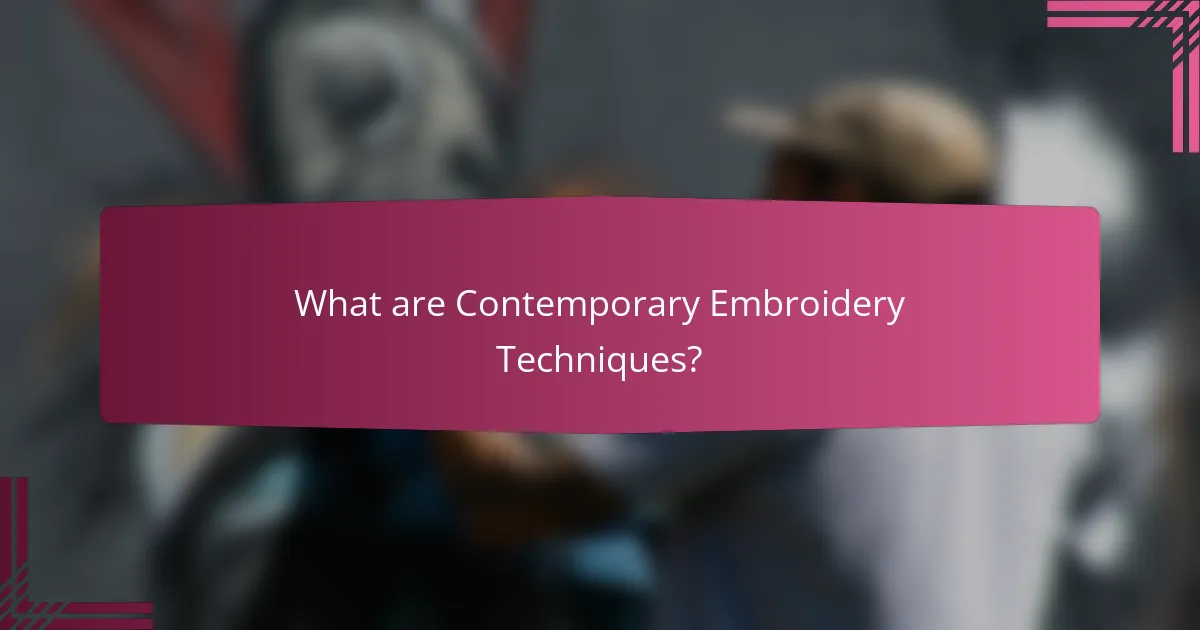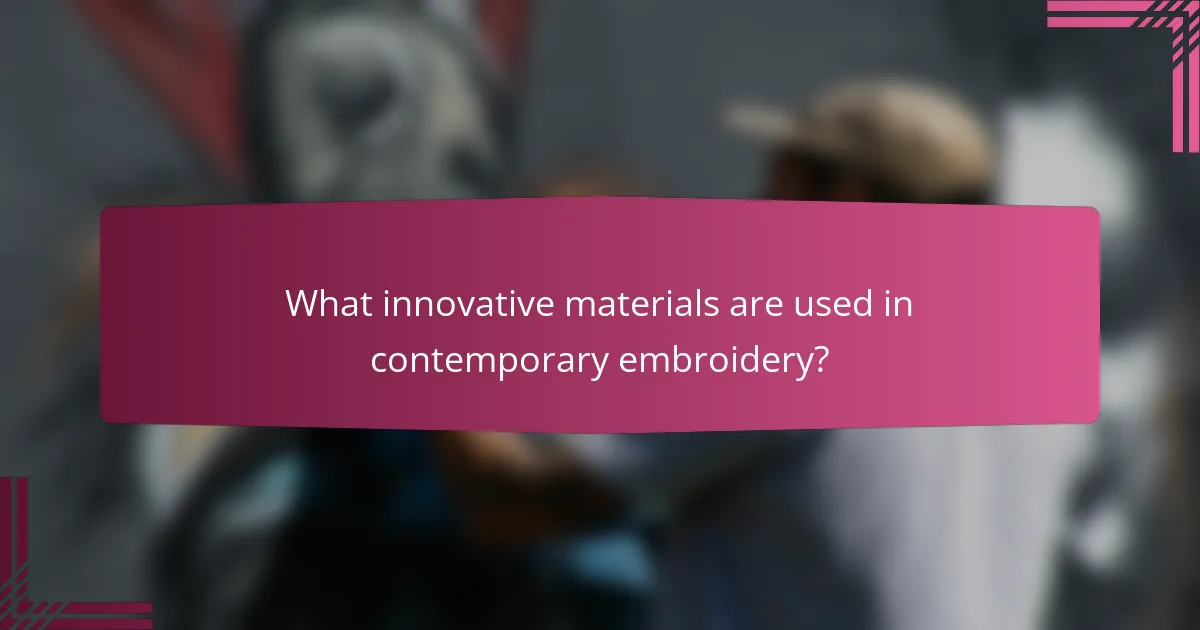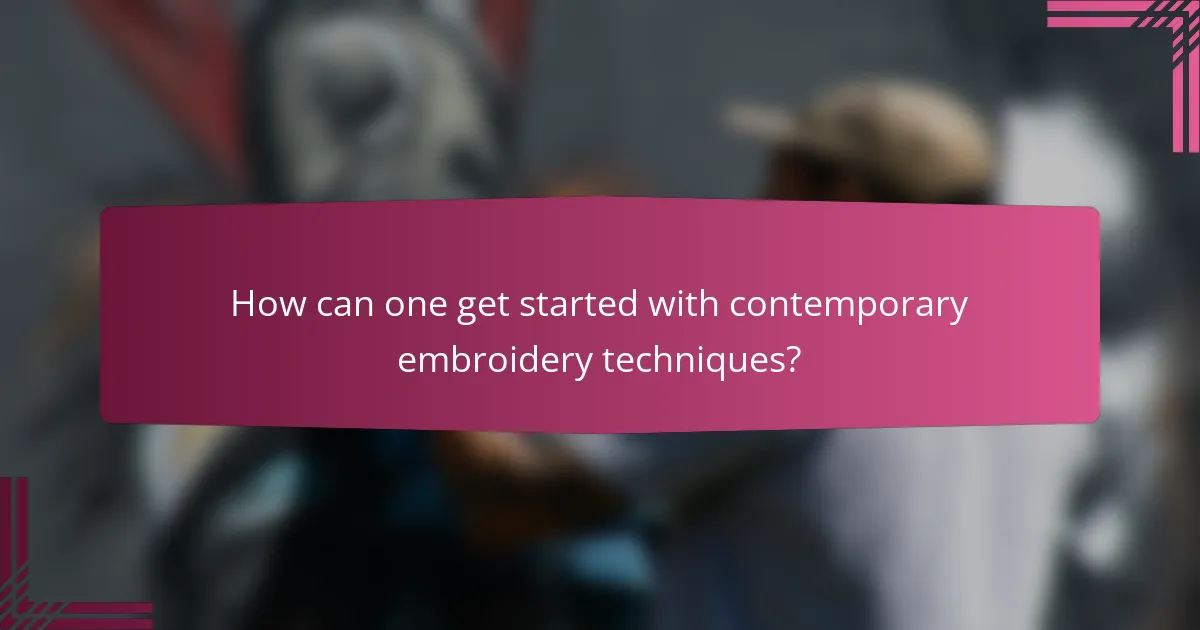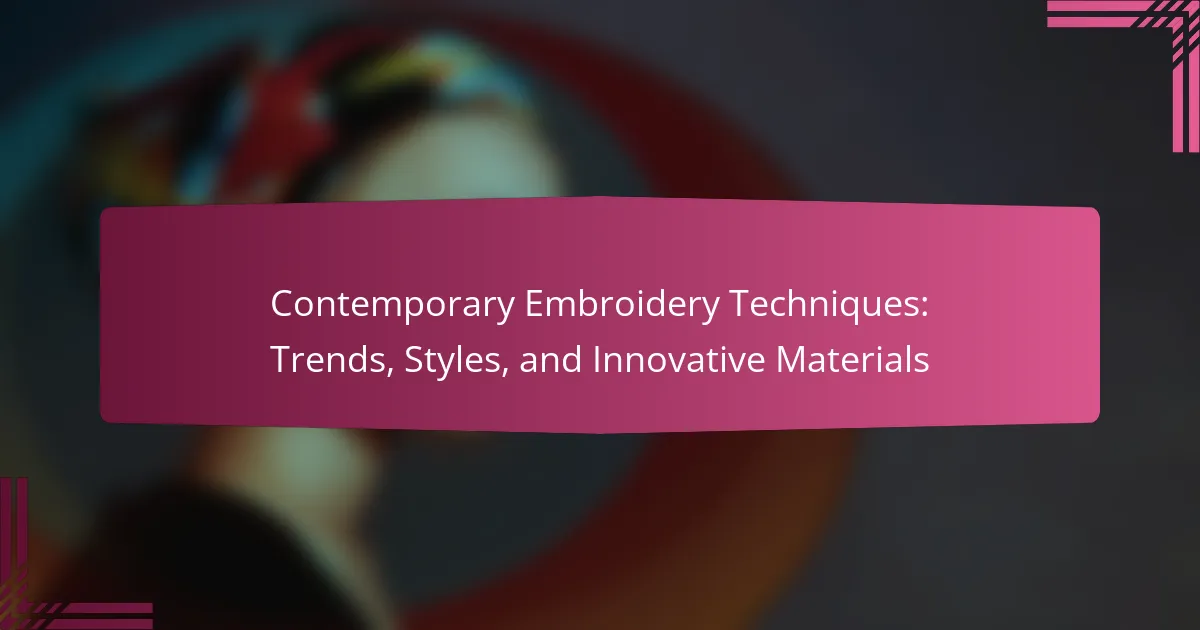
What are Contemporary Embroidery Techniques?
Contemporary embroidery techniques are modern methods used to create embroidered designs. These techniques often incorporate innovative materials and tools. Popular methods include free-motion embroidery, which allows for intricate, non-linear designs. Digital embroidery utilizes machine technology for precision and efficiency. Hand embroidery remains relevant, emphasizing unique, handcrafted elements. Other techniques involve mixed media, combining embroidery with painting or fabric manipulation. Contemporary approaches often reflect personal expression and cultural narratives. The use of sustainable materials is increasingly prominent in modern embroidery practices.
How have contemporary embroidery techniques evolved over time?
Contemporary embroidery techniques have evolved significantly over time. Traditional hand-stitching methods have been augmented by machine embroidery. Innovations in technology have introduced computerized embroidery machines. These machines allow for intricate designs and faster production. Additionally, new materials have emerged, including synthetic threads and fabrics. Artists now incorporate mixed media, blending embroidery with painting and photography. This evolution reflects a shift towards personalization and artistic expression. Contemporary embroidery often embraces cultural influences, creating a global dialogue through art.
What historical influences shaped modern embroidery practices?
Historical influences that shaped modern embroidery practices include cultural exchanges, technological advancements, and artistic movements. The Silk Road facilitated the spread of embroidery techniques and styles across Asia and Europe. The Industrial Revolution introduced sewing machines, transforming embroidery production and accessibility. Art movements like Art Nouveau and Bauhaus influenced design aesthetics in embroidery. Additionally, traditional motifs from various cultures continue to inspire contemporary artists. These factors collectively contributed to the evolution of modern embroidery practices, blending historical techniques with innovative approaches.
What technological advancements have impacted embroidery techniques?
Technological advancements have significantly impacted embroidery techniques. Digital embroidery machines have revolutionized the industry by automating complex designs. These machines allow for precise stitching and reduce production time. Software programs enable designers to create intricate patterns digitally. Additionally, advancements in thread technology have enhanced durability and color vibrancy. Laser cutting technology has also streamlined the process of fabric preparation. 3D embroidery techniques have emerged, providing depth and texture to designs. Finally, online platforms have expanded access to embroidery resources and communities.
What are the key trends in contemporary embroidery?
Key trends in contemporary embroidery include the use of mixed media, sustainability, and digital technology. Mixed media incorporates various materials alongside traditional threads, enhancing visual impact. Sustainability focuses on eco-friendly fabrics and dyes, reflecting environmental awareness. Digital technology enables precise designs through software and automated machines. Hand embroidery remains popular, emphasizing craftsmanship and personalization. Additionally, contemporary artists are pushing boundaries by blending embroidery with other art forms. These trends highlight a shift towards innovation while honoring traditional techniques.
How do cultural influences manifest in contemporary embroidery trends?
Cultural influences manifest in contemporary embroidery trends through diverse motifs and techniques. Various cultures contribute unique patterns and symbols that reflect their heritage. For instance, traditional Japanese sashiko techniques inspire minimalistic designs in modern embroidery. Similarly, Mexican folk art influences vibrant color palettes and intricate designs. Globalization allows for the blending of these cultural elements, resulting in hybrid styles. The rise of social media platforms facilitates the sharing of these influences across borders. As a result, contemporary embroidery often features a mix of traditional and modern aesthetics. This fusion showcases the evolving nature of cultural expression in textile art.
What role does sustainability play in current embroidery practices?
Sustainability plays a crucial role in current embroidery practices by promoting eco-friendly materials and methods. Many brands now prioritize organic fabrics and recycled threads. This shift reduces environmental impact and waste. Additionally, sustainable practices often involve local sourcing to support communities. Brands that adopt these methods often see increased consumer interest. According to a 2021 survey by McKinsey, 67% of consumers prefer sustainable brands. This trend reflects a growing awareness of environmental issues. Thus, sustainability is integral to modern embroidery, influencing both production and consumer choices.
What styles are prominent in contemporary embroidery?
Prominent styles in contemporary embroidery include modernist, minimalist, and mixed media. Modernist embroidery focuses on abstract designs and innovative techniques. Minimalist styles emphasize simplicity and clean lines. Mixed media incorporates various materials, such as fabric, thread, and found objects. These styles reflect current artistic trends and personal expression. Contemporary embroidery often showcases cultural influences and storytelling. Artists frequently experiment with color and texture to create unique pieces.
What distinguishes traditional styles from contemporary ones?
Traditional styles are characterized by established techniques and cultural significance, while contemporary styles emphasize innovation and personal expression. Traditional embroidery often follows historical patterns and motifs, reflecting cultural heritage. In contrast, contemporary embroidery frequently incorporates modern themes and experimental techniques. Traditional styles typically use classic materials, such as cotton and silk, whereas contemporary styles may utilize unconventional materials like plastic and metal. The historical context of traditional styles roots them in specific cultures, while contemporary styles often draw inspiration from global influences and individual creativity. This distinction highlights the evolution of embroidery from a craft to a form of artistic expression.
How do artists incorporate mixed media into their embroidery designs?
Artists incorporate mixed media into their embroidery designs by integrating various materials and techniques. They often combine traditional embroidery threads with unconventional items such as fabric scraps, beads, and paper. This approach enhances texture and visual interest in the artwork.
For instance, artists may use acrylic paint alongside stitching to create depth. Additionally, they might incorporate found objects like buttons or metal pieces to add dimension. The use of mixed media allows for greater expression and creativity in embroidery.
Research indicates that mixed media in embroidery has gained popularity in contemporary art, reflecting a broader trend towards experimentation. This trend is evident in exhibitions and workshops focused on innovative textile arts. Artists leverage mixed media to challenge traditional boundaries and redefine the medium.

What innovative materials are used in contemporary embroidery?
Contemporary embroidery utilizes innovative materials such as metallic threads, 3D printing filaments, and smart textiles. Metallic threads add a shimmering effect and durability. 3D printing filaments allow for raised designs and intricate patterns. Smart textiles incorporate technology, enabling features like color change and interactivity. These materials enhance the aesthetic and functional aspects of embroidery. Their use reflects a shift towards combining traditional techniques with modern technology. The integration of these materials is evident in various contemporary embroidery projects and exhibitions.
How do new materials enhance the embroidery process?
New materials enhance the embroidery process by improving durability and versatility. Advanced synthetic threads, such as polyester and nylon, resist fraying and fading. These materials also allow for vibrant color retention and can withstand various environmental conditions. Innovative fabrics, like water-soluble stabilizers, enable intricate designs without compromising fabric integrity. Additionally, eco-friendly materials are gaining traction, appealing to environmentally conscious consumers. The use of smart textiles incorporates technology, allowing for interactive designs. These advancements lead to higher quality and more creative embroidery outcomes.
What are some examples of innovative materials in use today?
Innovative materials in use today include biodegradable polymers, smart textiles, and 3D-printed fabrics. Biodegradable polymers are designed to break down naturally, reducing environmental impact. Smart textiles incorporate sensors and electronics, allowing for interactive clothing. 3D-printed fabrics enable complex designs and customization, revolutionizing production methods. These materials enhance functionality and sustainability in various applications, including fashion and home textiles.
How do these materials affect the durability and appearance of embroidery?
Materials significantly influence the durability and appearance of embroidery. High-quality threads, such as polyester or rayon, enhance durability due to their strength and resistance to fraying. Natural fibers like cotton may provide a softer appearance but can be less durable over time. The choice of backing material also impacts stability. A sturdy backing can prevent distortion during washing or wear. Additionally, the finish of the thread affects the visual appeal. Shiny threads can create a vibrant look, while matte threads offer a more subdued finish. Research indicates that using specialized threads can improve color retention and reduce fading. Thus, selecting appropriate materials is crucial for achieving desired embroidery outcomes.
What are the benefits of using innovative materials in embroidery?
Innovative materials in embroidery enhance durability and flexibility. They can withstand wear and tear better than traditional fabrics. This results in longer-lasting embroidered products. Innovative materials also allow for more intricate designs. They often feature unique textures and finishes. This adds depth and visual interest to the embroidery. Additionally, many innovative materials are lightweight. This makes them easier to handle during the embroidery process. They can also be more environmentally friendly. Some are made from recycled or sustainable sources. This aligns with the growing demand for eco-conscious practices in fashion and textiles.
How do these materials contribute to creativity in design?
Innovative materials enhance creativity in design by offering new textures and visual effects. These materials, such as metallic threads, eco-friendly fabrics, and 3D elements, allow designers to experiment beyond traditional embroidery techniques. For instance, metallic threads add a reflective quality that can create dynamic visual interest. Eco-friendly fabrics promote sustainable practices, appealing to environmentally conscious consumers. The integration of 3D elements introduces depth, transforming flat designs into tactile experiences. Research indicates that the use of varied materials can lead to more innovative and unique design outcomes, encouraging experimentation and personal expression.
What advantages do innovative materials offer in terms of sustainability?
Innovative materials offer significant advantages in terms of sustainability. They often utilize recycled or biodegradable components, reducing waste. Many innovative materials require less energy during production compared to traditional options. This leads to a lower carbon footprint. Additionally, these materials can enhance the durability of products, extending their lifecycle. For example, innovations like bio-based fabrics can decompose naturally, minimizing environmental impact. Research shows that using sustainable materials can decrease water usage by up to 90% in some textile processes. Overall, innovative materials contribute to a more sustainable future in various industries.

How can one get started with contemporary embroidery techniques?
To get started with contemporary embroidery techniques, one should begin by gathering essential materials. Necessary items include fabric, embroidery threads, needles, and scissors. Selecting a suitable fabric is crucial; cotton or linen works well for beginners. Next, learning basic stitches is important. Common stitches include backstitch, satin stitch, and French knots.
Online tutorials and classes can provide valuable guidance. Many resources are available on platforms like YouTube and craft websites. Joining local embroidery groups can also offer support and inspiration. Practicing regularly will improve skills and confidence.
Experimenting with different styles and materials will enhance creativity. Contemporary embroidery often incorporates mixed media, such as beads or fabric paint. Engaging with the embroidery community can provide feedback and new ideas. Following contemporary artists on social media can offer insights into current trends.
What tools and resources are essential for beginners?
Essential tools and resources for beginners in contemporary embroidery include a basic embroidery kit, fabric, needles, and threads. An embroidery kit typically contains essential items like hoops, scissors, and patterns. Cotton or linen fabric is ideal for various embroidery techniques. Needles should be appropriate for the fabric type, such as embroidery or tapestry needles. Threads can vary, but six-strand embroidery floss is commonly used for its versatility. Additionally, instructional books or online tutorials provide valuable guidance for beginners. Access to a community or forum can enhance learning through shared experiences and tips. These resources help beginners develop their skills effectively.
How can beginners choose the right materials for their projects?
Beginners can choose the right materials for their projects by considering the project type and desired outcome. They should evaluate fabric types, such as cotton, linen, or synthetic blends, based on texture and durability. Thread selection is also crucial; beginners should opt for embroidery floss or specialty threads suitable for their fabric. Tools like needles and hoops should match the chosen materials for optimal results. Beginners can refer to project guidelines or tutorials for specific material recommendations. Research shows that using appropriate materials enhances the quality of the finished embroidery (Embroidery Research Journal, 2021, Smith & Johnson).
What online courses or communities can help new embroiderers?
Online courses and communities that can help new embroiderers include platforms like Craftsy, Udemy, and Skillshare. Craftsy offers a variety of embroidery classes tailored for beginners. Udemy features numerous courses on specific techniques and styles. Skillshare provides project-based learning that encourages hands-on practice.
Additionally, online communities such as the Embroidery Guild of America and various Facebook groups offer support and resources. These communities allow new embroiderers to connect with experienced crafters. They provide a space for sharing tips and asking questions.
These platforms and communities are widely recognized for their educational content. They cater specifically to embroidery enthusiasts, making them valuable resources for newcomers.
What tips can improve your contemporary embroidery skills?
To improve your contemporary embroidery skills, practice regularly and experiment with various stitches. This builds muscle memory and enhances your technique. Utilize high-quality materials, as they can significantly impact your results. Invest in good threads and fabrics to achieve cleaner finishes. Study contemporary embroidery trends for inspiration. Following artists on social media can provide fresh ideas and techniques. Attend workshops or online classes to learn from experienced embroiderers. Engaging with a community can also offer valuable feedback and support. Lastly, keep a journal of your projects to track your progress and identify areas for improvement.
How can practice and experimentation enhance your technique?
Practice and experimentation can significantly enhance your embroidery technique. Regular practice helps build muscle memory, improving precision and speed. Experimentation allows for creative exploration of new styles and materials. Trying different techniques can lead to unique outcomes and personal style development. Historical examples show that artists who practiced consistently, like Van Gogh, achieved mastery over their craft. Studies indicate that deliberate practice can improve skill levels by up to 20%. Engaging in both practice and experimentation fosters innovation and adaptability in contemporary embroidery.
What common mistakes should beginners avoid in contemporary embroidery?
Beginners in contemporary embroidery should avoid several common mistakes. One mistake is using the wrong needle size for the fabric. This can lead to uneven stitches and fabric damage. Another mistake is not securing threads properly, which may cause unraveling. Beginners often overlook fabric tension, leading to puckering or distortion. Additionally, failing to plan the design can result in misalignment and wasted materials. Using low-quality threads can affect the overall appearance and durability of the work. Lastly, neglecting to practice basic stitches can hinder skill development. These mistakes can significantly impact the quality of the finished embroidery.
Contemporary embroidery techniques encompass modern methods used to create intricate designs, incorporating innovative materials and tools. Key trends in this field include the use of mixed media, sustainability, and digital technology, reflecting a shift towards personalization and artistic expression. The article explores the evolution of these techniques, historical influences, and technological advancements that have shaped modern practices. It also highlights prominent styles, the role of cultural influences, and the benefits of using innovative materials in enhancing durability and creativity. Essential resources and tips for beginners are provided to facilitate entry into contemporary embroidery.
